Part IX: Betty Boop Classique
Very broadly speaking the really classic Betty Boop cartoons are after the preliminary efforts that took a while to find her niche & personality (that is, after 1931), & before the Production Code of 1934 resulted in the Fleischer brothers' fearful self-censorship. Her film career can be divided into formative 1930-1931 when she didn't even yet have the name Betty Boop; classic Betty from 1932-1934, & the "increasingly for children" years 1934-1939.
That is not to say the later cartoons are all bad & the early ones all good. Some of the terrible ones were from the classic period; for racism you can't out-do I'll Be Glad When You're Dead You Rascal You (1932) of the classic period.
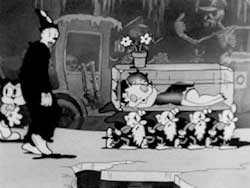 But as a generality there's a reason that an adult work of art like the Cab Calloway episodes Minnie the Moocher, Snow White, & Old Man of the Mountain are from 1932 & 1933 respectively, while all Betty's childish Pudgy the Puppy episodes don't get started until 1934. But as a generality there's a reason that an adult work of art like the Cab Calloway episodes Minnie the Moocher, Snow White, & Old Man of the Mountain are from 1932 & 1933 respectively, while all Betty's childish Pudgy the Puppy episodes don't get started until 1934.
Apart from Betty's sexier attitude (& shorter dress) in the classic period, the thing that really causes the finest episodes to stand among the best cartoons ever made in the whole history of cartoons is jazz.
Betty's theme song was ragtime. Now & then the songs she sang in the episodes were jazz numbers right out of the Roaring Twenties, & of course Betty's singing voice was imitated from one of the giants of ragtime New York, Helen Kane. In the Betty Boop Singalongs of 1932-1933, such pop singers as Rudy Vallee & Irene Bordoni made guest appearances.
Leonard Fleischer is the unsung Fleischer brother. Max produced, Dave directed, a host of animators brought the visions to fruition adding their own take on things. What was Leonard's greatest contribution? It was jazz. He was devoted to ragtime & hot jazz, collected the records, brought them to the studio offices, made everyone listen to them.
It was easier to match up lip movement to songs than to spoken phrases, as music's requirement of a beat suited animation in the early days of sound. So when talking cartoons came about many of them preferred to have dialolgue sung. But few other than the Fleischers' studio was paying attention to the best jazz of the day, & no others featured the likes of Cab Calloway & Louis Armstrong, guests in classic Betty Boop cartoons.
Initially Max Fleischer just took Leonard's advice & pointers toward great songs, & he stole them, getting no permission, paying no one. This got him in hot water very soon, & he ended up in face-to-face discussions with the musicians' representatives about correcting the situation.
To placate musicians Max came up with the idea of featuring the performers themselves as live action characters at the beginning of cartoons, & frequently characters would be formed around these performances, which is why Koko dances like Cab Calloway in Minnie the Moocher.
They were paid for their performances & they had what amounted to the very first music videos promoting their music, & the jazzmen no longer felt ripped off. At the same time penny-pinching Max could convince himself he hadn't actually paid for the songs, but for the guest appearances.
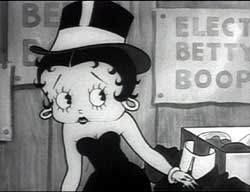 Another aspect of Betty Classique was that she was much more than just a sex object, though she certainly was that too. She even ran for President of the United States. Another aspect of Betty Classique was that she was much more than just a sex object, though she certainly was that too. She even ran for President of the United States.
To the chant of the crowd's "We want Betty!" our candidate sings her socialistic campaign song, which begins, "Some of you have money/ While some are poor you know/ If you send me to Washington/ I'll just divide the dough."
While doing her campaign song she impersonates forgotten politicians of the 1930s, & it is rather disconcerting to see that Betty Boop is an excellent male impersonator.
Betty Boop for President (1932) may seem awfully radical a theme for 1932, but in fact women had often run for President, even without hope of success. And the Free Love platform had sometimes been taken up by women candidates, so Betty's sexy image was surprisingly apropos.
A surreal sequence has a headless stick figure dancing & singing. The first verse runs: "Who am I? Who am I? Who am I? I'm Mr. Nobody. Who fills up your flour keg? Who cares if you have to beg? Who cares if you break a leg? Mr. Nobody!" In the midst of the Great Depression this is biting stuff.
The film goes into a fantasy of Betty in the presidential office. To donkeys & elephants she's singing, "What this country is in need of is a lot of hi de ho," but unfortunately it's not much of a hi de ho song, it's cartoon music rather than the sort of jazz that makes some Boop cartoons authentic hi do ho events.
Betty promises plenty of ice cream & cabarets, leading inevitably to a perfect nation. There follow a number of cartoon gags about President Boop's national improvements, like carpeting the streets, providing traffic cops with rocking chairs, trolly cars taking people off the tracks right to their doors, privacy booths around fire hydrants for dogs who need to pee, giant umbrellas over the cities for when it rains, & electric chairs replaced with machines that turn butch criminals into well-groomed faggots. The dangerous & the risque simply bounds across the screen.
Back from the fantasy, Betty gets a big campaign parade of animals concluding with a giant beer. This is a wonderfully wacky episode, & the gag about turning awful criminals into wonderful queers was certainly a startling bit of advocacy.
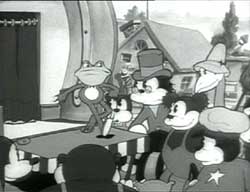 Betty Boop, M.D. (1932) places Betty, Bimbo, & Koko on the road as itinerant performers, & Betty a travelling snake oil saleswoman. The frog in her troupe doubtless intends to satirize MGM's rival star character, Flip the Frog.
Betty Boop, M.D. (1932) places Betty, Bimbo, & Koko on the road as itinerant performers, & Betty a travelling snake oil saleswoman. The frog in her troupe doubtless intends to satirize MGM's rival star character, Flip the Frog.
The tarp of her covered wagon advertises the phony patent medicine Jippo which promises to remove teeth, grow new tonsils, & stop breathing. She has a frog for an announcer, who first introduces Koko the Clown to do some visual gags & contortions before trying to sell Jippo to the crowd.
Betty comes out of the wagon to sing the jazz number "Now's the Time to Buy Jippo." The musical accompaniment & the whole film's sound effects & Bimbo's excellent singing are all the work of William "Red Pepper Sam" Costello, & Betty's vocals are by Mae Questel.
Though Koko failed to sell anything, no one can resist Betty's singing sales pitch. A wirey nervous guy tries Jippo & becomes enormously fat. An old man with a bad ticker tries it & turns into a giant baby. His infant grandson tries it & turns into a miniature old man. A bald guy tries it & his beard moves to the top of his head.
When Betty's dog Bimbo tries it it turns him into a crooner, singing a lovely tune "Nobody's Sweetheart," the sad story of a prostitute, while impractical miracles occur all around. Jippo turns out to be tapwater so all the side-effects would seem to have been psychosomatic.
I'd rate the music ten out of ten, & the cartoon the same. It's full of imagination & it's fun to find out Betty's such a crook.
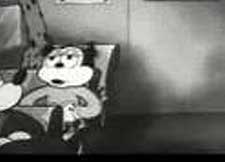 The Betty Boop Limited (1932) was actually the first film in which she is named Betty Boop. The "Limited' is a train that takes the Betty Boop Show's crew from place to place. While the train's in transit, Betty wants everyone to rehearse the show one last time before they arrive at their next gig.
The Betty Boop Limited (1932) was actually the first film in which she is named Betty Boop. The "Limited' is a train that takes the Betty Boop Show's crew from place to place. While the train's in transit, Betty wants everyone to rehearse the show one last time before they arrive at their next gig.
She goes first, singing "Ain't you kinda glad, & aint you kinda gay, when you hear me say I love you. Oh tell me baby, doncha?" It's a nice wee jazz tune. Her garter falls down to her ankles & a miniature character climbs on it & tries to drag it back up her leg.
Bimbo rehearses a juggling act. Koko rehearses a softshoe. Various animals practice their orchestral bits. Throughout, a talentless kitty tries to get attention singing an old-timey, "Darling I am growing older."
Everyone goes up on the roof of the train & dances & plays music, except a baby kangaroo who puts a coin in the pay-telephone slot & it pays off like a slot machine.
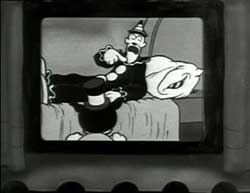 It closes with a couple gags about a cow on the track & the show never does arrive anywhere. I liked this episode which left me with one big surprise: There were pay phones on trains in 1932?? It closes with a couple gags about a cow on the track & the show never does arrive anywhere. I liked this episode which left me with one big surprise: There were pay phones on trains in 1932??
Betty is a headlining vaudeville star in Stopping the Show (1932). An animal band plays the overture, followed by a "Paramouse Noose Reel" spoof of a newsreel, with a number of news related gags.
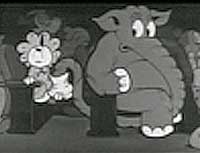 This is followed by a cartoon starring Bimbo & Koko. This is followed by a cartoon starring Bimbo & Koko.
Then it's time for the main live show called "Betty Boop's Imitations."
She first sings about a blue-eyed sweetheart, with her usual Helen Kane voice before going into her personation act. She does an impersonation of Fanny Brice singing "I'm an Indian."
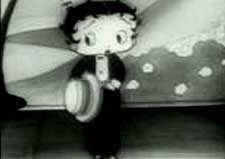 Lastly she does a Maurice Chevalier tune with his straw hat & tuxedo & heavy French accent, "How'd You Get So Beauitiful." Lastly she does a Maurice Chevalier tune with his straw hat & tuxedo & heavy French accent, "How'd You Get So Beauitiful."
The best bits from Stopping the Show were recycled in Rise to Fame (1934), along with bits from other episodes.
Max is being interviewed for the newspaper while drawing Betty Boop. The drawing comes alive so she can perform for the reporter.
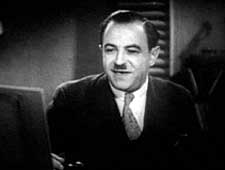 Max shows Betty a series of background drawings (for Bamboo Isle & Old Man of the Mountain, etc) letting her pick what she wants. Max shows Betty a series of background drawings (for Bamboo Isle & Old Man of the Mountain, etc) letting her pick what she wants.
She selects Stopping the Show & sings "Oh Me Oh My" followed by "I'm an Indian" in the manner of Fanny Brice, then reprises her Maurice Chevalier with straw hat & tux.
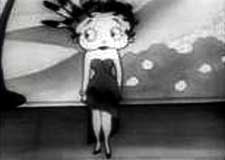 Essentially a money-saving "clips" episode," Betty leaps out of the backdrop & gets some ink on her face to perform her hoola dance from Bamboo Isle as the dark-skinned island maiden. Essentially a money-saving "clips" episode," Betty leaps out of the backdrop & gets some ink on her face to perform her hoola dance from Bamboo Isle as the dark-skinned island maiden.
She then leaps out of the island backdrop & goes behind some of Uncle Max's books to put on her sexy Old Man of the Mountain costume, which really was one of her best.
Even though a lot of it is recycled footage, it does mean concentrating some of Betty's best singing. In the end she climbs into Uncle Max's inkpot, accidentally splashing some ink on the reporter's face.
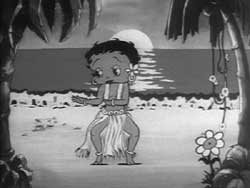 Bamboo Isle (1932) begins with a live-action guitar band & a fast-stepping hoola girl. They are Oceanic band the Royal Samoans. This leads into Betty Boop's island adventure to a Hawaiian beat.
Bamboo Isle (1932) begins with a live-action guitar band & a fast-stepping hoola girl. They are Oceanic band the Royal Samoans. This leads into Betty Boop's island adventure to a Hawaiian beat.
Bimbo the dog-boy is out motoring when his boat crashes on an island where Betty, a dark-skinned island girl, takes him for a boat ride.
She plays guitar for him as he croons an island tune, until they reach the waterfall. They tumble out of the boat into a tropical jungle, where the trees chant a tune just weird enough to creep out Bimbo, though Betty likes it.
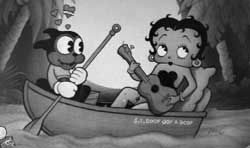 Suddenly going all racist, the island cannibals come after Bimbo. He puts a bone through his hair & darkens his face with mud in order to be made their king instead of getting eaten. The islanders stop chasing him & greet him with "Sholam aleichem!" & give him a throne & a cigar. Suddenly going all racist, the island cannibals come after Bimbo. He puts a bone through his hair & darkens his face with mud in order to be made their king instead of getting eaten. The islanders stop chasing him & greet him with "Sholam aleichem!" & give him a throne & a cigar.
The islanders are pretty much the same sorts of stereotypes seen when cartoons send characters to Africa, except for Betty who is a dark-skinned pretty hoola girl. She closes the cartoon with a hoola dance to the music of the Royal Samoans. She doesn't personally sing in this one but she's some hot dancer.
The hoola dance is wonderfully animated, thanks to rotoscoping the actual dancer seen at the beginning live-action portion of the film. That young woman's name was Meri, & she's dancer underneath Betty's movements.
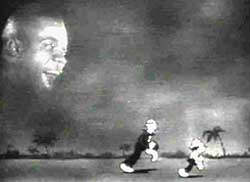 In spite of the wonderful dance, mainly this cartoon is difficult to forgive due to the racist stereotyping. When it rains & Bimbo's black face washes off, the islanders want to kill him again, so he grabs Betty, jumps in his boat, & hurries back to America. In spite of the wonderful dance, mainly this cartoon is difficult to forgive due to the racist stereotyping. When it rains & Bimbo's black face washes off, the islanders want to kill him again, so he grabs Betty, jumps in his boat, & hurries back to America.
And while coping with the sorry-ass fact of racism, it's time to look at what the Fleischer studio did with Louis Armstrong as the guest star of I'll Be Glad When You're Dead You Rascal You (1932).
Sachmo appears with his small orchestra in a live-action, & he provides all the jazzy instrumentation on the cartoon which ensues.
Cab Calloway just got awfully lucky with the thrilling supernally marvelous cartoons he did with the Fleischers. Sachmo didn't fare as well.
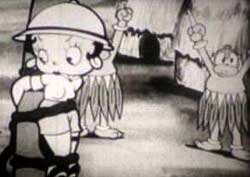 Bimbo & Koko are carrying Betty through the African jungle on a palanquin. Bimbo & Koko are carrying Betty through the African jungle on a palanquin.
The natives soon capture Betty. Koko & Bimbo end up in a cook pot surrounded by cannibals, but escape up palm trees that turn into stilts.
They're pursued by a specter of Sachmo's giant disembodied head singing "I'll Be Glad When You're Dead You Rascal You." Too bad it's so damned offensive with racist stereotypes, as that's a massively cool song.
Suddenly the cartoon is folded up like a curtain & there's Sachmo performing with his band. The curtain lowers & we're back with Koko & Bimbo who have to go save Betty from the cannibals, the chief cook for whom is Sachmo's drummer.
Using a porcupine for a weapon Betty's liberated & they all run for freedom. A volcano kills all the Africans. What a horrible cartoon. And the Fleischers did so well with Cab. How could they go so wrong with Sachmo? Stupidity mosty, though the Fleischers coopted this leopard-skin jungle-man image for Sachmo from one ofh is earliest film appearances, in Rhapsody in Black & Blue (1932).
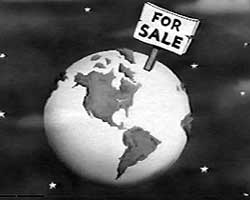 As a struggling entertainer of the Great Depression, Betty is occasionally shown to be the victim of poverty & loss. The house Betty & Bimbo have been living in is up for sale, & they have to find new digs in Betty Boop's Up & Downs (1932). As a struggling entertainer of the Great Depression, Betty is occasionally shown to be the victim of poverty & loss. The house Betty & Bimbo have been living in is up for sale, & they have to find new digs in Betty Boop's Up & Downs (1932).
With tears in her eyes she stands on the front porch for the last time, singing the blues: "I can't find a regular place that I can call my own."
We see that all the houses in town are for sale, not rent. In fact, the whole of America is for sale. Indeed, the whole earth, for the entire solar system has been taken over by sinister capitalists.
The Moon conducts an auction that all the other planets attend. Mars with a Roman helmet bids fifty. Venus, with Betty Boop's voice, raises the bid to forty. Saturn bids twenty.
Saturn now owns the Earth & just for fun takes gravity away, by removing a giant horseshoe magnet. Eerything on the face of the earth starts floating, including Betty & Bimbo & their horse-drawn cart. Betty goes running through the sky. When her skirt floats upward revealing her undies, she stands on her head to get her dress back in place.
Weightless gags & falling upward gags are numerous. Then the earth reaches out & grabs its magnet away from Saturn & puts it back inside itself, & gravity returns, Betty landing on a pillow.
For quick closure, a number of houses land one on top of another, & these become Betty's new home. A silly episode overall, but with a surprising political underpinning, & likeable overall.
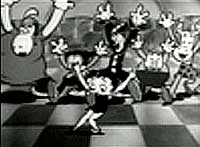 "Dancing to Save Your Soul" is a tapdance number written by popular songwriters Abel Baer & L. Wolfe Gilbert for Paramount on Parade (1930), sung behind the opening credits of The Dancing Fool (1932) by Mae Questal (as Betty) together with an unidentified male vocalist.
"Dancing to Save Your Soul" is a tapdance number written by popular songwriters Abel Baer & L. Wolfe Gilbert for Paramount on Parade (1930), sung behind the opening credits of The Dancing Fool (1932) by Mae Questal (as Betty) together with an unidentified male vocalist.
Bimbo is raising a window washer or sign-painter's platform up the outside of a tall building. When the platform slips & plunges downward, it's caught by two mice & Koko the Clown.
Koko has brought a paint bucket but no other painting equipment. After all sorts of antics it turns out they've been hired to paint lettering on a window at ground level, "Betty Boop's Dancing School."
She, Bimbo, & Koko sing a jazzy song taken from a 1928 hit, though sounds just like it could've been written for & about Betty: "Come On, Baby" by Archie Gottler, Sidney Clare & Maceo Pinkard.
There's some real songwriting talent incorporated here. Sidney Clare was the lyricist for "The Good Ship Lollipop." Gottler wrote the music for George Abbott's Broadway (1929), an early two-strip Technicolor musical.
Abel Baer songs were covered by Frank Sinatra & Paul Whiteman. L. Wolfe Gilbert's first great lyric was for "Waiting for the Robert E. Lee." And Maceo Pinkard's best remembered song is hands-down "Sweet Georgia Brown."
Bimbo & Koko join the school & Betty gives lessons on tap & jazz dance, with more than a touch of burlesque.
Sundry animals give amusing performances to ragtime. But soon the whole building is trying to dance, & everyone gets out barely in time before it crumbles into a heap.
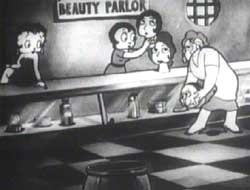 Betty &am Bimbo sing "Let's Go Crazy" on the trolly car. The trolly lets them off in Crazy Town (1932), where anything can happen. Fish fly in the sky & birds swim in the lake. Hats are worn on feet & shoes on heads.
Betty &am Bimbo sing "Let's Go Crazy" on the trolly car. The trolly lets them off in Crazy Town (1932), where anything can happen. Fish fly in the sky & birds swim in the lake. Hats are worn on feet & shoes on heads.
An elephant's trunk is shaped like a travel trunk.
When you peal a banana, you throw away in the inside, eat the peal, & walk off on your finger tips. Horses sweep human turds out of the street. Baldies go to barber shops to get hair snipped back on.
Ugly women go to the beauty parlor for new heads. Betty has to be careful as one of he shopping uglies spots her watching the crazy happenings & wants to buy her head.
The gags just keep coming one after another. A lion crows. The rhino meows. A mouse roars. A piano leaps out of the gorund for Bimbo to play, & Betty sings the title song one more time. It's all rather a lot of fun.
copyright © by Paghat the Ratgirl
|
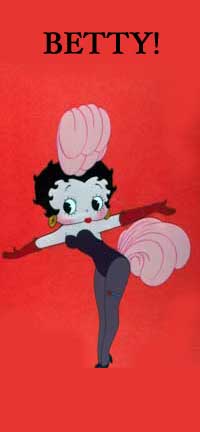
 But as a generality there's a reason that an adult work of art like the Cab Calloway episodes
But as a generality there's a reason that an adult work of art like the Cab Calloway episodes 


 It closes with a couple gags about a cow on the track & the show never does arrive anywhere. I liked this episode which left me with one big surprise: There were pay phones on trains in 1932??
It closes with a couple gags about a cow on the track & the show never does arrive anywhere. I liked this episode which left me with one big surprise: There were pay phones on trains in 1932?? This is followed by a cartoon starring Bimbo & Koko.
This is followed by a cartoon starring Bimbo & Koko. Lastly she does a Maurice Chevalier tune with his straw hat & tuxedo & heavy French accent, "How'd You Get So Beauitiful."
Lastly she does a Maurice Chevalier tune with his straw hat & tuxedo & heavy French accent, "How'd You Get So Beauitiful." Max shows Betty a series of background drawings (for Bamboo Isle & Old Man of the Mountain, etc) letting her pick what she wants.
Max shows Betty a series of background drawings (for Bamboo Isle & Old Man of the Mountain, etc) letting her pick what she wants. Essentially a money-saving "clips" episode," Betty leaps out of the backdrop & gets some ink on her face to perform her hoola dance from Bamboo Isle as the dark-skinned island maiden.
Essentially a money-saving "clips" episode," Betty leaps out of the backdrop & gets some ink on her face to perform her hoola dance from Bamboo Isle as the dark-skinned island maiden.
 Suddenly going all racist, the island cannibals come after Bimbo. He puts a bone through his hair & darkens his face with mud in order to be made their king instead of getting eaten. The islanders stop chasing him & greet him with "Sholam aleichem!" & give him a throne & a cigar.
Suddenly going all racist, the island cannibals come after Bimbo. He puts a bone through his hair & darkens his face with mud in order to be made their king instead of getting eaten. The islanders stop chasing him & greet him with "Sholam aleichem!" & give him a throne & a cigar. In spite of the wonderful dance, mainly this cartoon is difficult to forgive due to the racist stereotyping. When it rains & Bimbo's black face washes off, the islanders want to kill him again, so he grabs Betty, jumps in his boat, & hurries back to America.
In spite of the wonderful dance, mainly this cartoon is difficult to forgive due to the racist stereotyping. When it rains & Bimbo's black face washes off, the islanders want to kill him again, so he grabs Betty, jumps in his boat, & hurries back to America. Bimbo & Koko are carrying Betty through the African jungle on a palanquin.
Bimbo & Koko are carrying Betty through the African jungle on a palanquin.

